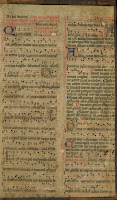 Sometimes all the magnificence of a rare book is on full display - perhaps it features a jeweled binding, illuminated paintings, ornamented clasps, or fine printing. Other times its beauty is hidden away, possibly in a fore-edge painting. Or perhaps its charms are literally under wraps, such as the scrap paper used to line the inside covers of the book and bind them to the pages. For these endpapers (also called pastedowns), early printers used whatever materials were lying about: scrap paper, excess pages from large print runs . . . and even illuminated vellum manuscript pages, as in our example here.
Sometimes all the magnificence of a rare book is on full display - perhaps it features a jeweled binding, illuminated paintings, ornamented clasps, or fine printing. Other times its beauty is hidden away, possibly in a fore-edge painting. Or perhaps its charms are literally under wraps, such as the scrap paper used to line the inside covers of the book and bind them to the pages. For these endpapers (also called pastedowns), early printers used whatever materials were lying about: scrap paper, excess pages from large print runs . . . and even illuminated vellum manuscript pages, as in our example here. Friday, October 15, 2010
What Lies Beneath
 Sometimes all the magnificence of a rare book is on full display - perhaps it features a jeweled binding, illuminated paintings, ornamented clasps, or fine printing. Other times its beauty is hidden away, possibly in a fore-edge painting. Or perhaps its charms are literally under wraps, such as the scrap paper used to line the inside covers of the book and bind them to the pages. For these endpapers (also called pastedowns), early printers used whatever materials were lying about: scrap paper, excess pages from large print runs . . . and even illuminated vellum manuscript pages, as in our example here.
Sometimes all the magnificence of a rare book is on full display - perhaps it features a jeweled binding, illuminated paintings, ornamented clasps, or fine printing. Other times its beauty is hidden away, possibly in a fore-edge painting. Or perhaps its charms are literally under wraps, such as the scrap paper used to line the inside covers of the book and bind them to the pages. For these endpapers (also called pastedowns), early printers used whatever materials were lying about: scrap paper, excess pages from large print runs . . . and even illuminated vellum manuscript pages, as in our example here. Our copy of a Corpus Juris Civilis was published in Paris in 1559. It was bound in three volumes, all of which feature a fine calf leather binding and the gold tooled initials "RB" in honor of an early owner, Dr. Robert Bysshop. Open the covers of all three volumes, and you will be surprised by beautiful illuminated manuscript pages featuring Latin text and early musical notation.
These volumes, donated to us by Daniel R. Coquillette, are some of my favorites in our collection. If anyone knows how to read the notation and sing the music, I would love to hear it!
Subscribe to:
Post Comments (Atom)



No comments:
Post a Comment